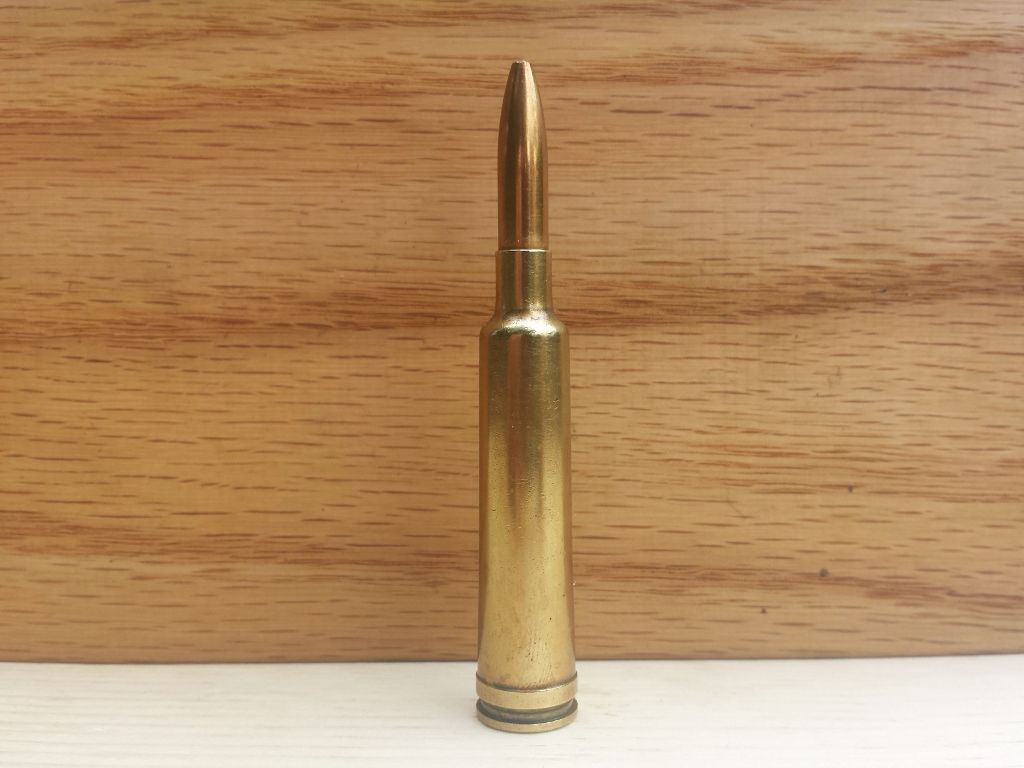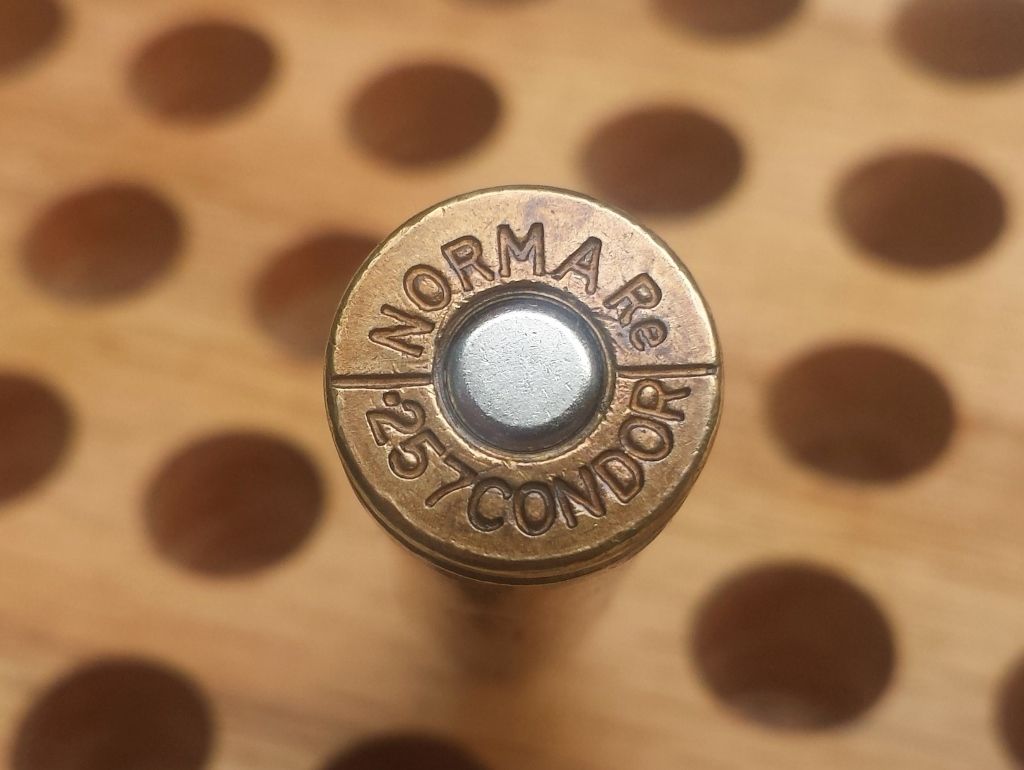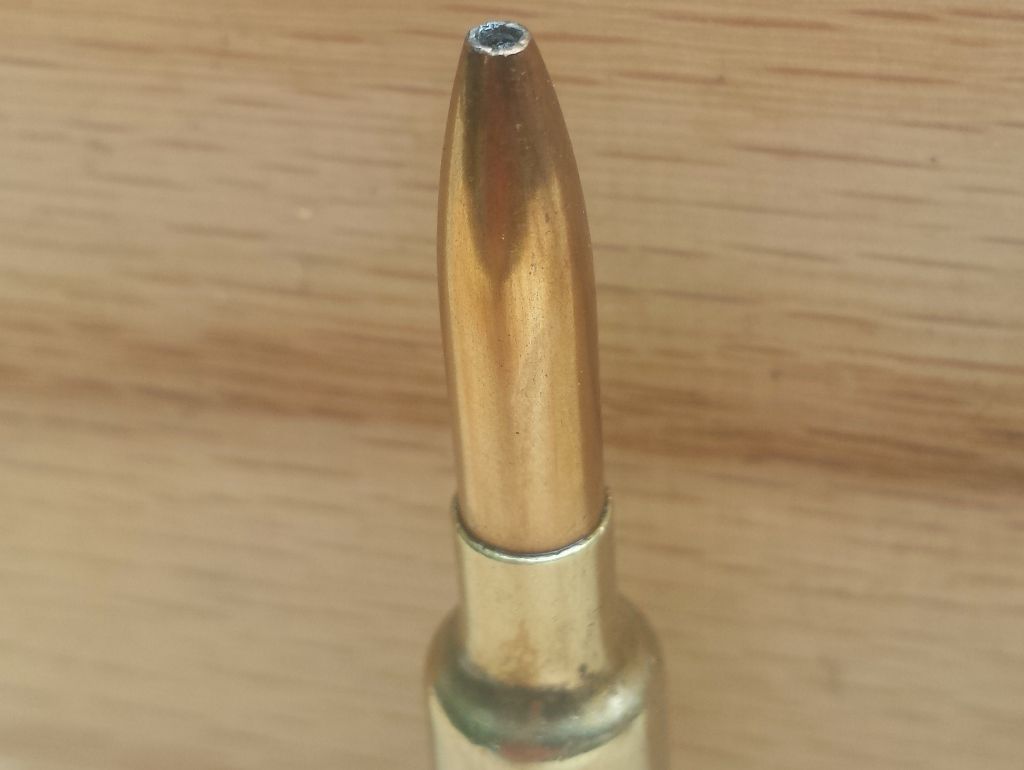|
|
Post by Lee Martin on Oct 13, 2016 19:21:22 GMT -5
 Since age 10 I’ve collected cartridges, particularly the obscure kind. I thought it would be neat to devote a thread to wildcats, proprietary rounds, and the obsolete. The requirements to add a cartridge are simple. Just include a picture and some history. Unique is good, rare is even better. -Lee www.singleactions.com"Chasing perfection five shots at a time" |
|
|
|
Post by Lee Martin on Oct 13, 2016 19:34:24 GMT -5
 The .257 Condor’s roots date back to 1946. Dr. Ramon Somavia of Hollister, California conceived the purpose built round for hunting. Long-range hunting to be exact. Somavia lived on a huge ranch where open range shots on deer could exceed 500 yards. Clean kills at that distance demanded flat trajectory and ample retained energy. His brainchild would be predicated on bullets of unusually high sectional density. He also sought less recoil than the larger .300 Weatherby and H&H Magnum. Add deep penetration to the wish list too; the good doctor planned to use the cartridge in Alaskan and Africa. Relative to their paper ballistics, hunters found the 175 gr 7x57 and 160 gr 6.5 Mannlicher possessed great killing power. It seemed high-SDs and tough construction made-up for moderate muzzle energy. Ramon settled on a 160 grain spitzer in .25-caliber. The boiler room would be belted magnum brass. Two cases were tested. The .257 version used .300 H&H’s cut to ’06 length. A larger .258 Condor was done on untrimmed H&H. Little came of the .258. I suppose it was too much of a good thing. Marginal velocity gain, higher recoil, and reduced barrel life probably sunk it. However the .257 showed promise. Somavia fried dozens of barrels before committing to the design shown below. By then (circa 1956) Norma was producing 7 x 61 Sharp & Hart. Dr. Somavia placed an order for 50,000 S&H’s necked down to twenty-five. Norma obliged and even worked with him on the bullet. Pressures tests were done with an array of powders and hull capacities. Efficiency increased as shoulders approached 30 degrees. Sharper angles gave erratic combustion with available propellants. Final specs were 2.400” total length, a 30 degree shoulder, minimal body taper, and an adequate neck. On to the bullets. Traditional copper jacketed 160’s failed miserably on every front. Out of 1:6.5” and 1:7” twist barrels they came apart in flight, making accuracy potential moot. With no means to reduce friction or centrifugal forces, a steel jacket was tried. Using Shelby tubing, Atkinson & Marquart of Arizona formed the jacket cups. That solved the disintegration problem but the trade-off was rampant rifling wash. Some barrels died after only 200 shots. Eventually Norma switched to a trio-metal, not unlike our Government’s .30-M2 Alternate. I won’t get into the specifics other than to say gilding metal coated the jacket’s inner and outer walls. This protected the bore and improved lead adhesion. Norma filled Somavia’s order in the late 1950’s. The original ask of 50,000 shells wasn’t quite met. Only 12,000 were drawn along with 100,000 bullets and 500 boxes of loaded ammunition. Ramon’s .257 Condor had landed. With standardized components, a fresh set of tests were undertaken. Swedish powders quickly proved unusable. The pressure curves they generated behind the big 160 were scary. American powders, like IMR 4350 and 4831 worked well as did H-570. Regardless of the fuel, barrels burned out fast at peak levels. 4140 chrome moly was good for maybe 300 firings. Beyond that, fire-cracking and lead wash was so severe they couldn’t even be setback. Timken steel, with its higher graphite content, eased erosion a bit. Still, service life rarely went much more than 1,000 shots. Lands were always held to 0.250” as different groove sizes were assessed. 0.257” spiked pressure and dropped velocity by 300 fps. 0.258” added 200 fps across the entire curve. 0.259” tanked speeds and accuracy. Nearly all .257 Condors wore 0.258” barrels and 1:7” twist. That combo gave mean velocities of 2,900 fps with the 160 Norma. 54.5 grs of 4350 and a Winchester #120 provided the umph. Sighted 2.0” high at 100 and POA and POI converge at 300 yards. Plenty flat, though they tinkered with Norma’s 120 grain over 60.0 grs of 4350. Sparked by a Federal #210, it went 3,375. The 120 never shipped as loaded ammunition, only the rocket-like 160. No doubt today’s slower powders could boost either bullet by 100 – 150 fps. There aren’t many .257 Condors out there. Dr. Somavia built 35 – 40 and Fred Wells chambered another 50. However niche, it had its “15 minutes” during the 50’s speed era. Commercial offerings like the .257 Weatherby and .264 Winchester Magnum duplicate it. And while brass can be formed from any belted base, there is no source for 160 grain bullets. Dropping down to nominal 25-cal weights makes the Condor a straight shouldered Weatherby. Why bother, right? I was able to obtain a loaded round for my collection:     -Lee www.singleactions.com"Chasing perfection five shots at a time" |
|
|
|
Post by 2 Dogs on Oct 13, 2016 19:35:42 GMT -5
We have a lot in common. How many guys have owned a 224 Clark?
|
|
|
|
Post by Lee Martin on Oct 13, 2016 19:38:08 GMT -5
Fermin - you're the only other guy I know that's owned a .224 Clark. It'll make it into this thread in due time. -Lee www.singleactions.com"Chasing perfection five shots at a time" |
|
|
|
Post by mart on Oct 13, 2016 21:36:38 GMT -5
 While the two on the left, 30-06 and 35 Whelen, are not unusual the one on the right is a bit different. It is the 400 Whelen. The late Michael Petrov inspired me to build one after his awesome research on the round. I had always had an interest in it and when Michael came out with his articles it was the impetus I need to build one of my own. The round was brought to life by Colonel Townsend Whelen in 1923 after his 38 Whelen fell victim to a shortage of available bullets. Winchester had discontinued the bullets for the 38-72 that he was using in the 38 Whelen. Apparently no other .375 bullets were readily available. Colonel Whelen bumped the bullet diameter up to .411 and the shoulder diameter to .458 from the .441 of the parent 30-06 case. That makes it one of the earliest improved type wildcat cartridges. Even though Elmer Keith was quite fond of the 400 Whelen, it languished in obscurity for several decades. The occasional writer would take a swipe at from time to time touting it's lack of shoulder on which to headspace. Many thought it was simply the 30-06 case bumped up to .411 until Michael Petrov wrote his excellent works debunking the headspace myth. Michael's exhaustive research soundly put to rest any notion the 400 Whelen suffered from headspace issues. My own work with the round has proved Michael right in his assessment of the 400. I have sent a little over 1000 rounds down the pipe of mine and never had a failure to fire. I've even attempted to cause a headspace failure by putting a super annealed case in front of the extractor in an attempt to force the slight shoulder back and thereby set up an excessive headspace situation. I've not been able to make it fail. But enough of the boring headspace stuff. The 400 Whelen is a great cartridge, fully capable of hunting anything on this planet. It duplicates the 450/400 Nitro Express ballistics with a 400 grain bullet at 2150 fps. The 300 grain can run to 2400 and the 350 to 2250-2300. I don't know if Whelen was trying to duplicate the 450/400 in a magazine rifle. I've heard it opined that he was but I doubt anyone knows for sure. With 58 grains of H4895 and a 400 grain bullet, caribou and moose fall nicely. I haven't equaled Elmer's 11 head of big game with mine yet but it has two caribou and one moose to its credit and has become my all time favorite big game rifle. Mine is built on a left handed model 70 Winchester classic. Brass is available from Quality Cartridge and once in a while a guy stumbles onto some Norma cylindrical 30-06 brass. It can be made from 30-06 and 35 Whelen fairly easily with an expander die. My dies, both reloading and expanding dies for this round are from CH4D. They have a great array of dies for wildcat rounds. Bullets are available from Hornady, Barnes, Woodleigh, North Fork, Swift and Hawk. I've used the Woodleigh 400 grain, Hawk 400 grain and Barnes 300 grain TSX to take game. |
|
cmh
.401 Bobcat
  
Posts: 3,745
|
Post by cmh on Oct 14, 2016 6:11:26 GMT -5
Read about it sparingly Mart, very neat round Sur thanks for the education as I always liked the 35 Whelen.
|
|
|
|
Post by Rimfire69 on Oct 14, 2016 6:54:00 GMT -5
This is going to be a good one, can't wait to see what shows up here.
|
|
|
|
Post by magnumwheelman on Oct 14, 2016 8:18:52 GMT -5
I'll do up something on the 22 Velo-dog... I have a revolver & a couple boxes of cartridges, as well as dies I can reload with... can also do something on the 257 Special... even though all my stuff is "home manufactured" I did not develop the cartridge... actually the more I think about it... the more I have to contribute... lots of contender only cartridges, etc... seems I like the unique & obscure  I'll start with the Velo-dog though... I expect to see something from COOGS on the 357 Maximum  |
|
ericp
.327 Meteor
 
Posts: 522
|
Post by ericp on Oct 14, 2016 9:30:29 GMT -5
 Photo credit to Ammo-One, I'm currently traveling for work. 22 Savage High PowerWhile not a wildcat, I think this cartridge qualifies here due to it's odd bullet diameter and obsolescence. It was also an early contributor to the light bullet/high velocity vs heavy bullet/moderate velocity debate. The 22 Savage High Power, or Imp (as in "impish", not "improved"), was created by Charles Newton in 1912 for the Savage Model 99 levergun. The original factory load was a .228" 70 gr soft point traveling at an advertised 2800 fps from an unspecified length (although probably 26-28") barrel. Designed as a combination varmint and big game cartridge it quickly gained in popularity as Savage proudly showcased the cartridge taking very large and dangerous game in it's advertisements. WDM Bell shot Cape buffalo with it and HR Caldwell killed a couple of tigers with his. Despite these successes it quickly became clear that it was not an adequate big game cartridge after some well publicized failures on dangerous game. Average deer hunters also wounded a fair amount of game with it. The rudimentary jacketed bullets of the day surely contributed to this as well. I've been shooting the 22 High Power for about 8 years now and it has become a favorite for hunting coyotes and dealing with pest critters like porkies and skunks. Factory ammo was available from S&B under the name of 5.6x52R but has recently been discontinued. Hornady occasionally makes a 70 gr .227" bullet for the High Power but in addition to being undersized it is overly long and on the ragged edge of being stabilized in most rifles. I use .224" Hornady 60gr soft points and bump them up to .228" in a homemade die. These are loaded to 3100 fps with Reloader 7. The High Power is also cursed with an unfortunate combination of cartridge/chamber dimensions. It is a member of the 30-30 family but is actually based on the 25-35 which for reasons unknown is usually found with a smaller base diameter than the rest of the 30-30 family. The chamber on most rifles encountered (I've had 4 of these so far and made chamber casts of 3 others) is on the generous side of 30-30 chamber tolerances. This leads to a nasty expansion ring on fired factory cases and extremely short case life, 3-4 firings at most. I use 30-30 brass for forming my 22 High Power, preferably Hornady as it has the largest base diameter of readily available brass and I back off the full length sizing die a half a turn which improves case life. If forming cases from 30-30 brass you'll need to turn the necks for use with proper diameter bullets. The High Power is most commonly found in takedown rifles. These tend to be picky but can be made to shoot pretty well. My current one will do 1.25-1.5" groups @100 yards with a small Lyman Alaskan 2.5x in place. It can be an immensely frustrating cartridge to load but I like the Model 99 and feel it is worth the effort to shoot this oddball of the 30-30 family. Eric |
|
|
|
Post by mart on Oct 14, 2016 10:09:49 GMT -5
Eric,
Great write up on the High Power. I'd love to see your bump up die and learn how you made and use it.
Mart
|
|
ericp
.327 Meteor
 
Posts: 522
|
Post by ericp on Oct 14, 2016 11:02:28 GMT -5
Mart,
I sent you a PM to keep this thread on topic.
Eric
|
|
|
|
Post by 2 Dogs on Oct 14, 2016 11:17:22 GMT -5
Wow Mart. Thanks for your excellent post on the 400 Whelen!
Anyone here got anything on the 338/378 KT?
|
|
|
|
Post by 2 Dogs on Oct 14, 2016 11:18:26 GMT -5
This is going to be a good one, can't wait to see what shows up here. I agree. One of Lee's better ideas for sure!! |
|
|
|
Post by 2 Dogs on Oct 14, 2016 11:29:29 GMT -5
Eric, sent you a PM.
|
|
|
|
Post by mart on Oct 14, 2016 11:54:28 GMT -5
2 Dogs,
Nothing on the 338/378KT but when I get home from the slope and can take some pictures I'll do some write ups on the 10.75x57, 6mmx222 and 256 Mannlicher.
Mart
|
|